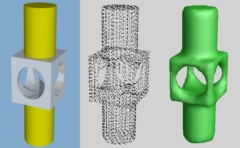
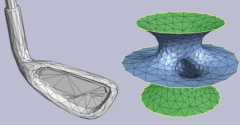
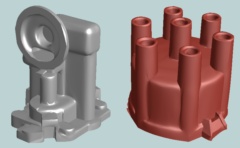
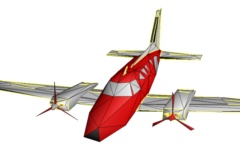
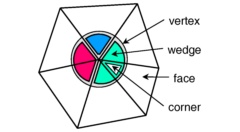
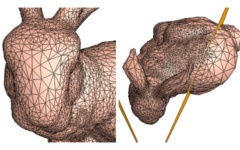
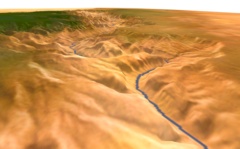
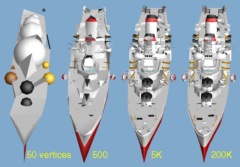
This GitHub package contains a C++ library and several application programs that demonstrate mesh processing technologies published in research papers at ACM SIGGRAPH in 1992–1998:
The source code follows modern C++11 style and is designed for cross-platform use.
2016-04-28 — initial release.
The source code can be compiled with Microsoft Visual Studio 2015 from the included solution (*.sln) and project (*.vcxproj) files, using either the Integrated Development Environment (IDE) or the msbuild command.
On Unix-based platforms (including Linux, Mac OS, and Cygwin),
the code can also be compiled using gcc and clang compilers
(and Visual Studio cl compiler)
using Makefiles designed for GNU make.
Reading/writing of images and videos is enabled using several options.
If available, image I/O can use libpng/libjpeg or Windows Imaging Component (WIC).
Video I/O can use Windows Media Foundation (WMF).
Across all platforms, if the command ffmpeg
is present in the PATH,
it is spawned in a piped subprocess for both image and video I/O.
On Mac OS X, it is necessary to install
XQuartz for X11 support and
ffmpeg for image/video I/O.
Open the distrib.sln file and build the solution (typically using the "ReleaseMD - x64" build configuration).
Executables are placed in the bin, bin/debug, bin/Win32, or bin/Win32/debug directory, depending on the build configuration (64-bit versus 32-bit, and release versus debug).
msbuildSet the appropriate environment variables and run msbuild, e.g.:
(Some alternatives are to set platform to Win32, or configuration to DebugMD, Release, or Debug; here MD stands for multithreaded DLL.)
Executables are placed in the same target directory as in the IDE.
makeThe CONFIG environment variable determines
which make/Makefile_config_* definition file is loaded.
On Windows, CONFIG can be chosen among {win, w32, cygwin, mingw, mingw32, clang},
defaulting to win if undefined.
On Unix-derived platforms (including Linux and Mac OS), CONFIG=unix is the unique and default setting.
For example, to build using the Microsoft cl compiler (Debug, with 8 parallel processes, placing *.exe into directory bin/win):
To build all programs (into either bin/unix or bin/win) and run all unit tests:
To build on Unix, forcing the use of the gcc compiler (the alternative is clang):
To build just the main library using the mingw gcc compiler on Windows:
To build the Filtermesh program (into bin/clang) using the clang compiler on Windows:
To build all programs (into bin/cygwin) and run all demos using the gcc compiler under Cygwin:
To clean up all files in all configurations:
Note that additional options such as debug/release, 32-bit/64-bit, and
compiler tool paths/parameters are set in the various make/Makefile_* files.
These need to be adjusted depending on the versions and installation paths of the tools.
For instance, the line
"rel ?= 0" in make/Makefile_config_win specifies a debug (non-release) build, and
"$(call prepend_PATH,...)" in make/Makefile_base_vc sets the compiler directory.

|
ACM SIGGRAPH 1992 Proceedings, 71-78.
Signed-distance field estimated from a set of unoriented noisy points.
programs: Recon
demos: create_recon_*.{sh,bat}, view_recon_*.{sh,bat}
|

|
ACM SIGGRAPH 1993 Proceedings, 19-26.
Traversing the space of triangle meshes to optimize model fidelity and conciseness.
programs: Meshfit
demos: create_recon_*, view_recon_*, create_simplified_using_meshopt, view_simplified_using_meshopt
|

|
ACM SIGGRAPH 1994 Proceedings, 295-302.
Subdivision surfaces with sharp features, and their automatic creation by data fitting.
programs: Subdivfit
demos: create_recon_cactus, view_recon_cactus
|

|
ACM SIGGRAPH 1996 Proceedings, 99-108.
Efficient, lossless, continuous-resolution representation of surface triangulations.
demos: create_geomorphs, view_geomorphs
|

|
Computers & Graphics, 22(1), 1998, 27-36.
Progressive mesh data structures compatible with GPU vertex buffers.
demos: create_pm_club, view_pm_club, determine_approximation_error
|

|
ACM SIGGRAPH 1997 Proceedings, 189-198.
Lossless multiresolution structure for incremental local refinement/coarsening.
demos: create_sr_office, view_sr_office
|

|
IEEE Visualization 1998 Conference, 35-42.
Visually smooth adaptation of mesh refinement using cascaded temporal geomorphs.
demos: create_terrain_hierarchy, view_terrain_hierarchy, create_sr_terrain, view_sr_terrain, view_gcanyon_*
|

|
ACM SIGGRAPH 1997 Proceedings, 217-224.
Progressive encoding of both topology and geometry.
programs: G3dOGL
demos: view_psc_drumset
|
After the code is compiled, the demos can be run as follows.
In Windows, create, view, and clean up all the results using the batch scripts
On Unix-based systems (e.g. Linux, Mac OS, Cygwin), either run the bash scripts
or alternatively (and faster), invoke make to create all results in parallel and then view them sequentially:
Note that pressing the Esc key closes any open program window.
All programs recognize the argument --help (or -?) to show their many options.
The programs Filterimage, Filtermesh, Filtervideo,
FilterPM, and Filterframe are all designed to:
std::cin (or from files or procedures specified as initial arguments),std::cout (unless -nooutput is specified).For example, the command
alpha=0) rectangular region in the image center,std::cerr), andAs another example, the command
The command
spheretext.s3d file.The command
The command
- for std::cin) together with the original video in an interactive viewer,This program reads a list of 3D (x, y, z) points assumed to be sampled near some unknown manifold surface, and reconstructs an approximating triangle mesh. For example,
To show the progression of the Marching Cubes algorithm,
To show a similar streaming reconstruction of the surface mesh,
The same program can also read a list of 2D (y, z) points to reconstruct an approximating curve:
Given an initial mesh and a list of 3D points, this program optimizes both the mesh connectivity and geometry to improve the fit, i.e. minimizing the squared distances from the points to the surface. For example,
The input points can also be sampled from an existing surface, e.g.:
To view the real-time fitting optimization,
This related program performs a similar optimization of a 1D polyline (either open or closed) to fit a set of 2D points. For example,
In a subdivision surface representation, a coarse base mesh tagged with sharp edges defines a piecewise smooth surface as the limit of a subdivision process. Such a representation both improves geometric fidelity and leads to a more concise description.
1e-5 per vertex and .2e-5 per sharp edge, andTo view the result,
This program computes measures of differences between two meshes. It samples a dense set of points from a first mesh and computes the projections of each point onto the closest point on a second mesh.
MeshDistance loads the earlier results of mesh reconstruction and mesh optimization,Given a mesh, MeshSimplify applies a sequence of edge collapse operations to simplify it to a coarse base mesh while trying to best preserve the appearance of the original model. It supports many different simplification criteria, as well as face properties, edges tagged as sharp, and vertex and corner attributes
(nx,ny,nz normals, r,g,b colors, and u,v texture coordinates).
For example,
*.prog file, andThe next step is to reverse the sequence of stored edge collapses, i.e. forming a progressive sequence of vertex splits:
We construct a concise progressive mesh by encoding the base mesh together with the sequence of vertex splits that exactly recover the original mesh:
The complete process from the original mesh to the progressive mesh is implemented by the script call
Given a progressive mesh, we can interactively traverse its continuous levels of detail:
We can also define geomorphs between discrete levels of detail, e.g.
This example displays a progressive mesh after truncating all detail below 300 faces and above 10000 faces:
As an example of simplifying meshes with appearance attributes,
Within demos/create_sr_office, the script call
creates a progressive mesh
in which the simplified vertices are constrained to lie at their original positions (-vsgeom).
This enables selective refinement, demonstrated by
The mesh is adaptively refined within the view frustum, shown as the inset rectangle (key Do) or in the top view (key Dr). Drag the mouse buttons to rotate, pan, and dolly the object.
Within demos/create_sr_terrain.{sh,bat},
Then, within demos/view_sr_terrain.sh,
For large terrain meshes, we form a hierarchical progressive mesh by partitioning the terrain mesh into tiles, simplifying each tile independently to form a progressive mesh, stitching the progressive meshes together 2-by-2, and recursively simplifying and merging at coarser pyramid levels.
An example is presented in demos/create_terrain_hierarchy.
It makes use of
to assemble each 2-by-2 set of progressive mesh tiles terrain.level0.x{0,1}.y{0,1}.pm at the finest level.
The script demos/view_gcanyon_interactive launches an interactive flythrough over a Grand Canyon terrain model,
using a progressive mesh precomputed from an original 4096×2048 height field.
Alternatively, demos/view_gcanyon_frames shows a real-time flythrough using a pre-recorded flight path, whereby keystroke commands embedded within the input stream automatically change viewing modes.
The program MinCycles removes topological noise from a mesh
by iteratively pinching off the smallest nonseparating cycle of edges until a
specified criterion (cycle length, number of cycle edges, number of cycles, or mesh genus) is reached.
For example, within demos/create_topologically_simplified.{sh,bat},
.10The G3dOGL program shows interactive rasterized renderings of 3D (and 2D) geometry,
represented as
*.a3d format),*.m),*.pm),*.srm),*.psc), or*.ply files.Please see the many examples presented earlier.
The viewer can also read *.frame elements to position the viewer and the objects in world space.
Elements of *.a3d, *.m, and *.frame streams can all be interleaved in a single input stream.
The viewer can take image snapshots (see demos/create_rendered_mechpart_image) and record videos (see demos/create_rendered_mechpart_video).
The mouse/keyboard UI controls include:
Mouse movements: left mouse: rotate middle mouse: pan right mouse: dolly shift-left: pan shift-middle mouse: roll shift-right mouse: zoom (mouse movements are with respect to current object; see '0-9' below) Important key strokes: ? : print complete list of keys D?: print list of keys prefixed by 'D' De: toggle edges Ds: toggle shading of faces Db: toggle backface culling Dm: toggle Gouraud/flat shading DP: save current window as an image file DS: toggle show some sliders S : toggle show some other sliders j : jump to a default viewpoint J : automatically rotate object D/: edit viewpoint filename , : read the viewpoint . : save the viewpoint 0-9: select object (0=eye_frame, 1=first object, 2=second object...) u : display/hide current object N : select next object P : select previous object -=: decrease/increase the magnitude of all movements f : toggle flying (usually with '0' eye selected)
To record a 6-second (360-frame) video of a rotating mesh and then view the resulting video:
The related program G3dVec shows wireframe hidden-line-removed renderings of *.a3d streams and *.m meshes.
It can write vector-based Postscript figures (see demos/view_hidden_line_removed).
In both programs, the keys ? and D? show a list of available keyboard commands.
The VideoViewer program enables interactive viewing and simple editing of both images and videos.
Again, the key ? shows a list of available keyboard commands.
Press pageup/pagedown to quickly browse through the videos and/or images in a directory.
Audio is not currently supported.
*.m)See the documentation at the end of libHh/GMesh.h
A mesh is a set of vertices and faces. These in turn also define edges and corners.
Arbitrary string tuples can be associated with vertices, faces, edges, and corners.
Examples of string tuples:
{normal=(.1 .2 .3) rgb=(1 1 1) matid=5 material="string"}.
See the several demos/data/*.m files for examples of the mesh format.
Note that the indices of vertices and faces start at 1 instead of 0;
in hindsight that was a poor choice.
*.a3d, *.pts)See the documentation at the end of libHh/A3dStream.h
The stream contains polygons, polylines, points, and control codes (like end-of-frame, end-of-input, change-of-object). Unlike in a mesh, these primitives do not share vertices. The stream can be either text or binary.
*.frame, *.s3d)See the documentation at the end of libHh/FrameIO.h
This text or binary format encodes a 4×3 affine transformation (plus an object id and a scalar field-of-view zoom). It is used to record default viewing configurations, and sequences of frames for flythroughs. It usually represents the linear transform from object space (or eye space) to world space. The stream can be either text or binary.
*.pm)This is a binary representation that consists of a coarse base mesh and a sequence of vertex split records.
*.prog, *.rprog)These are temporary text files containing verbose information for a sequence of edge collapse / vertex split records used by MeshSimplify / reverselines / Filterprog to create a progressive mesh.
The library libHh contains the main reusable classes.
All files include Hh.h which sets up a common cross-platform environment.
The libraries libHWin and
libHWX define different implementations
of a simple windowing interface (class HW),
under Win32 and X Windows, respectively.
Both implementations support OpenGL rendering.
The include file libHh/RangeOp.h defines many functions that act on ranges,
which are containers or views for which begin() and end() are defined.
For example, the function call hh::fill(ar, 1.f) assigns the value 1.f to all
elements in the array named ar,
and the function call hh::mean(matrix) computes the average value of all entries in the
named matrix.
The debugging macro SHOW(expr) outputs expr = ... on std::cerr
and also returns expr.
It also accepts multiple arguments in which case it returns void.
For example, SHOW(min(1, 2), "hello", 3*2) outputs the line min(1, 2)=1 hello 3*2=6.
Note the special treatment of literal string values.
Unicode strings are stored using UTF-8 encoding into ordinary std::string variables.
The functions hh::widen() and hh::narrow() convert to and from the
std::wstring UTF-16 encodings used in Win32 system calls.
All files use end-of-line encodings based on Unix '\n' LF (rather than DOS '\r\n' CR+LF). All streams are opened in binary mode. This allows text and binary to coexist in the same file.
See the file ./license.txt.
This project has adopted the Microsoft Open Source Code of Conduct. For more information see the Code of Conduct FAQ or contact opencode@microsoft.com with any additional questions or comments.